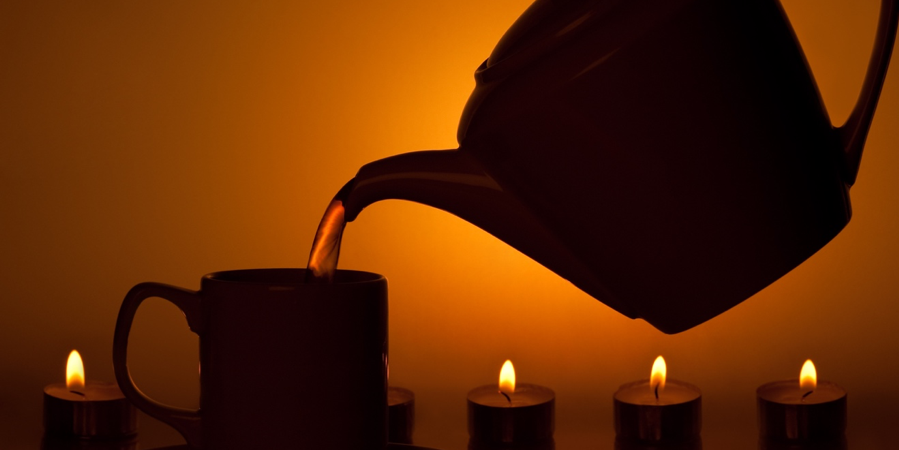
It was a cold, wet and windy spring day. I had a meeting with a bank advisor about my RSP and things like that and had to drive a little ways through traffic to her office.
I’d operated earlier and was feeling a little tired, and when I’m tired, like most people, I get easily chilled. There’s also a feeling of hyper-stimulation after hours of surgery that for example used to keep me up for several hours after late night surgery for hand trauma. During the daytime, it may leave me feeling a little on edge. So I wanted something warm and a bit of a pick-me-up but calming at the same time. As I often do during the winter, I made myself a thermos of tea. My go-to is a black tea grown in China called Keemun. I drank a little on the way while driving and immediately felt better.
I came into her office and we sat down at a smallish round table. She walked over to her desk and asked if wanted coffee, or maybe something else to drink. She’s a very bright, cheerful, fit, modern, and cultured Asian woman in her early to mid-40s. I said no thank you to her offer of a drink and, pointing to my thermos, I offered her some of my tea. She said, “It’s probably really good for you; full of anti-oxidants”. I said something like, “People have been drinking tea and discussing its benefits for thousands of years. The biochemistry is kinda late news”, and we both laughed.
What I was trying to say is that anti-oxidant science is maybe of some interest, but to me, it doesn’t have the gravitas of ancient wisdom. Sometimes we don’t need to wait for the “scientific proof”
I quit drinking coffee in the morning for a little while during medical school. I think that lasted about 8 months. I do love my morning coffee. But I have always enjoyed the gentle stimulant effect of tea and can drink it much later in the day without it upsetting my sleep cycle.
“The effect provided by tea is like being gently encouraged to do something by a loving grandmother, while coffee is like being kicked in the butt by a military officer.”
Kris Gunnars BSc in a very good piece on Healthline on the 10 Health Benefits of Green Tea.
On the other hand, if you are, or are around someone who happens to be, familiar with chemistry, this might also be of interest to you: Coffee, Tea, Mat
When I was growing up, tea pretty much was a “Red Rose” tea bag steeped for three to five minutes yielding an orange-coloured liquid high in tannins astringent to the palate and tasting quite bitter. Most people sweetened it with sugar and added either milk or, less commonly, lemon. It was marketed as “Orange pekoe” but I now know was anything but FTTGFOP (Finest tippy Golden Flower Orange Pekoe) instead is mainly the powder and crumbs left from the leaves, basically the bottom of the barrel, put in tea bags.
“The highest grades for Western and South Asian teas are referred to as “orange pekoe”, and the lowest as “fannings” or “dust”. Pekoe tea grades are classified into various qualities, each determined by how many of the adjacent young leaves (two, one, or none) were picked along with the leaf buds. Top-quality pekoe grades consist of only the leaf buds, which are picked using the balls of the fingertips. Fingernails and mechanical tools are not used to avoid bruising.
When crushed to make bagged teas, the tea is referred to as “broken”, as in “broken orange pekoe” (“BOP”). These lower grades include fannings and dust, which are tiny remnants created in the sorting and crushing processes”
See Tea leaf grading on Wikipedia.
Having moved to Vancouver in 1969 I discovered Murchie’s as a teen. The original Murchies (the original family no longer owns it) were in Vancouver and Victoria and had something profoundly different. I soon learned about Earl Grey (Darjeeling tea with oil of Bergamot), Jasmine, Russian caravan, Oolong, and even Lapsang Suchon ( which to me tastes a little too much like a pinewood campfire, and many others.
A few years ago, I discovered a gem on Vancouver Island, The Westholme Tea Farm.

Located in the Cowichan Valley, between Chemainus and Duncan is a place I visit whenever I have a chance. It is the first commercial tea farm in Canada, and when I tell people about it, they are incredulous. Tea farming? Here?
This is a long-term project and a labour of love. Victor and Margaret have something there that is so cultivated, so beautiful and so peaceful I think it is a must-see for anyone. They sell their own teas which are grown on a small scale and they also sell excellent teas from all over, the best I have ever tasted. Margaret is also a potter and her ceramics are exquisite.

I highly recommend a visit to Westholme Tea if you find yourself in the town of Duncan on Vancouver Island.
As I write this, it is again a rainy, windy, chilly spring day. I started the day with a delicious cup of coffee (more on that some other time, perhaps). But it’s mid-afternoon and I am enjoying a pot of Keemun Mao Feng, tea I purchased at the Westholme tea farm.
Keemun (literally: ‘Qimen red tea’) is a famous Chinese black tea. First produced in the late 19th century, it quickly became popular in the West and is still used for a number of classic blends. It is a light tea with characteristic stone fruit and slightly smoky notes in the aroma and a gentle, malty, non-astringent taste reminiscent of unsweetened cocoa. Top varieties have orchid-like fragrances and additional floral notes in the flavor.
“Among the many varieties of Keemun perhaps the most well-known is Keemun Mao Feng (祁門毛峰). Harvested earlier than others, and containing leaflets of two leaves and a bud, it is lighter and sweeter than other Keemun teas. Another high-grade variety, containing mostly leaves and stronger than others, is the Keemun Hao Ya (祁門毫芽).”
There is something remarkably peaceful about sipping a cup of tea, alone, or with good company.

Dr. Gelfant’s Living Beautifully Blog
Join our mailing list and receive updates when a new blog is posted by Dr. Benjamin Gelfant.